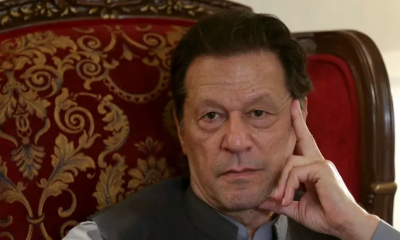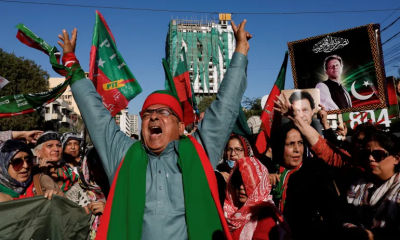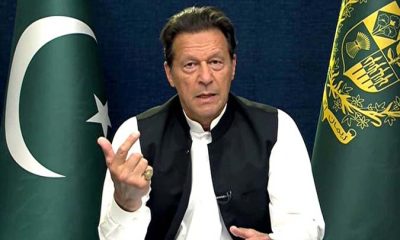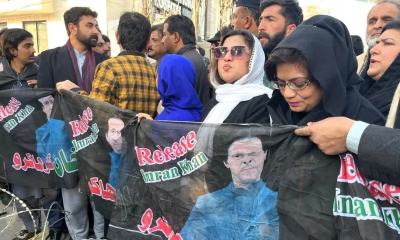Latest News
Pakistan election: PTI joins religious parties, PPP backs rival PMLN
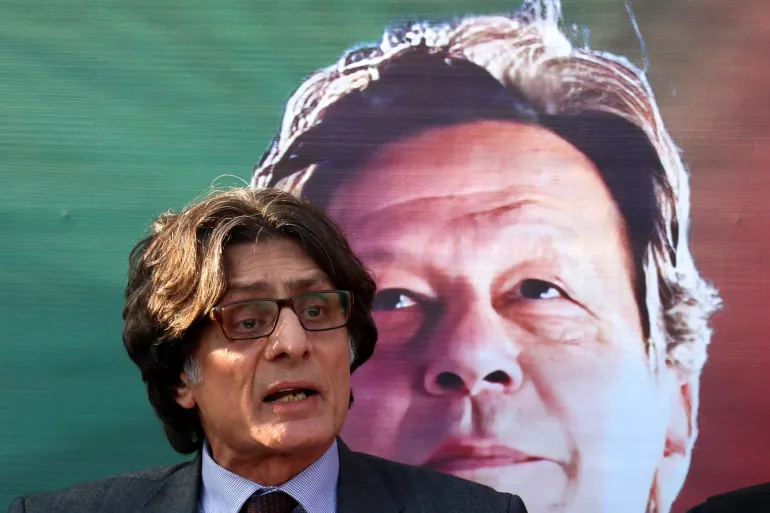
Five days after Pakistan’s general election, two opposing parties, Pakistan Tehreek-e-Insaf (PTI) and Pakistan Peoples Party (PPP), have both announced plans to form a government – with the PTI allying with religious parties and the PPP forming a coalition with rival Pakistan Muslim League-Nawaz (PMLN).
The PTI leadership on Tuesday announced that its independent candidates would try to form a federal government and one in Punjab province by joining a coalition with the minority party Majlis-e-Wahdat-Muslimeen (MWM).
The party also said its candidates in Khyber Pakhtunkhwa province would ally with another religious party, Jamaat-e-Islami (JI), to form a government.
Thursday’s elections delivered a split mandate with no party securing a majority in the National Assembly. Independent candidates affiliated with jailed former Prime Minister Imran Khan’s PTI won the most seats. But to form a government, they still need to be part of a political party or a coalition.
In announcing the coalition plan on Tuesday, PTI spokesperson Raoof Hasan said he had been mandated by Khan to approach all political parties other than the “PPP, PMLN and MQM”, or Muttahida Qaumi Movement.
“Imran Khan has a clear message that formation of a government is the right of who had won the elections,” Hasan said at a press conference in Islamabad.
Former cricketer Khan was ousted from power in a parliamentary vote of no confidence in April 2022. The PTI was also forced to field its candidates as independents after its electoral symbol, a cricket bat, was stripped from it in January for violating election laws.
Khan has maintained he will not engage with three-time former Prime Minister Nawaz Sharif’s PMLN or former Foreign Minister Bilawal Bhutto-Zardari’s PPP, calling them “corrupt”.
In Thursday’s polls, PTI-backed candidates emerged on top with 93 seats in the National Assembly whereas the PMLN was the single biggest party with 75 seats. The PPP was the third highest with 54 seats. To form a government, a party or coalition needs a simple majority of 134 seats in the National Assembly out of the 266 that were voted on during the general election.
Besides the 266 directly elected seats, an additional 60 seats are reserved for women and 10 for minorities. Those seats are distributed among parties according to the ratio of seats they won, but independents will not receive these quota seats.
While two parties can form a coalition and still retain their individual identity and policies, independent candidates, once they join a party, must adhere to that party’s discipline and decisions.
The PTI has insisted that its singular majority was stolen in the election due to alleged tampering and vote manipulation. Barrister Gohar Ali Khan, the PTI’s interim party chief, said on Tuesday that the PTI believes it has won 180 seats, instead of 93. “We will share a white paper with all the details,” he added. Neither Hasan nor Gohar Ali Khan said who would be the party’s candidates for prime minister, speaker and deputy speaker in parliament.
Coalition between PPP and PMLN
Hours after the PTI’s announcement, the PPP and PMLN said at a press conference that they would form a new coalition and join with smaller parties to lead the country.
Although they did not specify who would lead the government, PMLN spokesperson Marriyum Aurangzeb said on the social media platform X that Nawaz Sharif had nominated his younger brother and Former Prime Minister Shehbaz Sharif for the post.
Earlier on Tuesday, Bhutto-Zardari, the PPP chairperson, said his party would endorse the PMLN’s candidate for the position of prime minister and would align with it.
He said the PPP decided against taking any role in the cabinet, and he would not be putting his name forward for the premiership, “We do not have the mandate to form a government in the federation, and therefore, I will not be putting myself forward for the candidacy of the prime minister,” he said during a press conference in Islamabad.
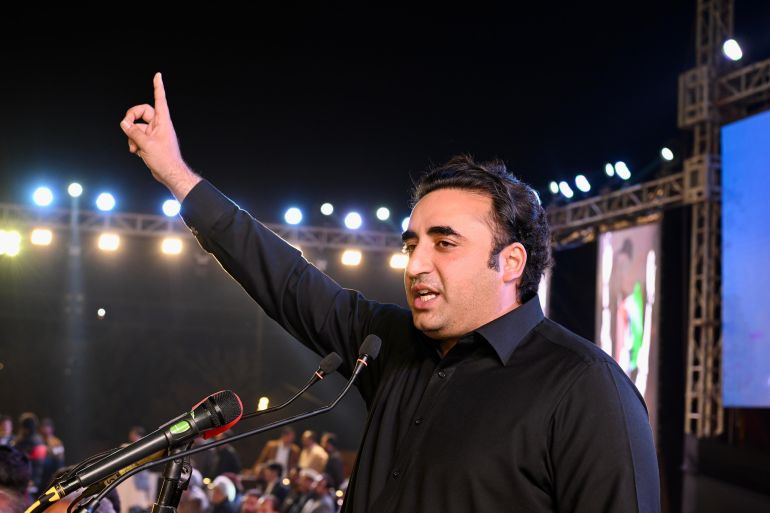
Bhutto-Zardari expressed his desire to see his father, former President Asif Ali Zardari, return to that position while also announcing the party would put candidates forward for Senate chairperson and speaker of the National Assembly.
“We ran this election on the manifesto based on public importance, and we want to restore political stability and want to end this environment of political toxicity,” the PPP chairperson said.
Political analyst Benazir Shah said the decision by the PPP seems to be a smart move. “The PPP has been trying to make inroads into Punjab, Pakistan’s most populous province, for the past few years. This is an opportunity for them to spend the next five years mobilising their party in the province, especially since these election results show weakening of PMLN’s vote bank,” she told Al Jazeera. “The PPP has its eyes set on 2029, not on 2024.”
Regarding the PTI, analyst Mehmal Sarfraz said it was incumbent on the party to ensure its winning candidates join the MWM so party discipline applies to them and they cannot jump ship.
However, she questioned Imran Khan, for refusing to engage with other political parties.
“This is not about any principle. This is about Khan’s narrative of hate against these parties and his divisive politics. It is unfortunate that PTI is not willing to talk to any other mainstream political party. Democracy is also about co-existence and tolerating other’s point of view, but PTI’s politics is essentially ‘either with us or against us’,” she told Al Jazeera.
Shah concurred, saying that while the election results show that Pakistani voters want to see the PTI in office, it appears Khan is still adamant on “politics of confrontation”.
“His refusal to sit with the PPP to form a government signals that Khan is still not ready to sit with political parties in the larger interest of democracy,” she added.
Sarfraz believes that, given the circumstances, the PPP made the right call by joining the PMLN alliance, adding that it is the PMLN that needs the PPP, not the other way around.
“No party has the numbers to form a government on its own. Ideally, the PPP would have wanted Bilawal Bhutto-Zardari to be the leader of the opposition. But options are limited, especially because of the PTI’s rigid stance. So this is effectively the only thing they could have done,” the Lahore-based analyst said.
(Aljazeera)
Latest News
‘Bloody policies’: MSF recovers 11 bodies from Mediterranean off Libya
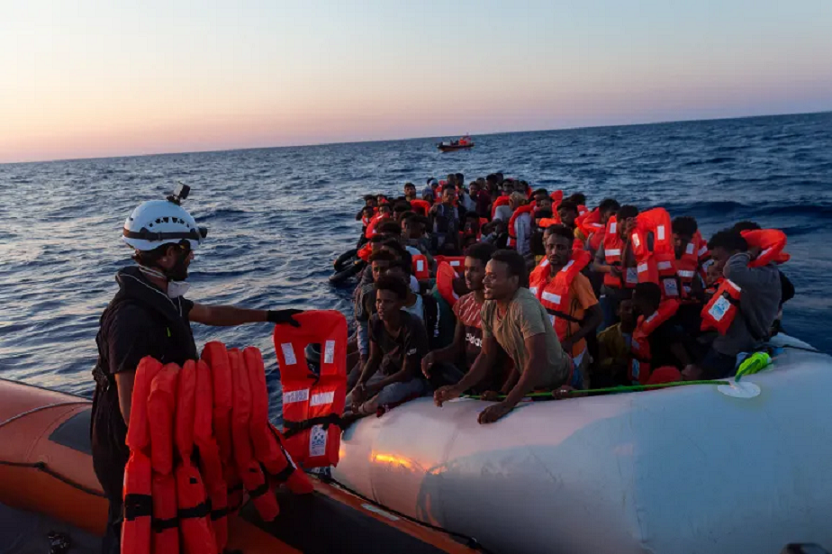
The aid group Doctors Without Borders has reported recovering 11 bodies and rescuing dozens of people off the coast of Libya as it criticised the migration policies of the North African country and European countries.
In a statement on Friday, the group, known by its French initials MSF, said its Geo Barents rescue vessel managed to recover the bodies following a search operation lasting more than nine hours after being alerted by German nongovernmental organisation Sea-Watch, which also rescues refugees and migrants.
“As we cannot determine the reason behind this tragedy, we know that people will continue to take dangerous routes in a desperate attempt to reach safety, and Europe must find safe and legal pathways for them,” MSF said in a post on X. “This catastrophe must end!”
Sea-Watch said it is unclear whether the bodies were victims of a previously unknown shipwreck, adding that they tried to contact Libya’s coastguard to go and retrieve the dead, but received no reply.
“The so-called Libyan coastguard – financed by the EU – ignored our call demanding that the bodies be recovered,” the group said.
Thousands of people trying to head from Africa to Europe use Libya as a departing point, with the Italian island of Lampedusa the nearest European destination as they undertake the dangerous journey across the Mediterranean to escape war, poverty and persecution.
Italy, which wants to put a stop to the migration stream, has said Libya and neighbouring Tunisia must do more to stop people from going to sea. It has also clamped down on the operation of the rescue ships, arguing that they encourage people to head to Europe, a charge that is denied by the charities.
Emphasising its policy on the rescue ships, Italy said on Friday that it forced the MSF rescue vessel to take the 165 people that it had saved from boats in the Mediterranean operation to the northern port of Genoa. The port was more than 650 nautical miles (1,200km) from their position and much farther than the more convenient ports in nearby Sicily, significantly delaying assistance to the rescued.
The route in the central Mediterranean is the most dangerous migrant crossing in the world, with the United Nations registering more than 20,000 deaths and disappearances in the area since 2014.
More than 3,000 refugees and migrants went missing in 2023 while attempting to use the route, according to the International Organization for Migration.
According to Italy’s interior ministry, the number of arrivals in the country has dropped in 2024 to fewer than 21,800 people since the beginning of the year, compared with close to 53,300 in the same period last year.
[Aljazeera]
Latest News
Mustafizur, Rishad, Hridoy dazzle in Bangladesh’s tight two-wicket win over Sri Lanka
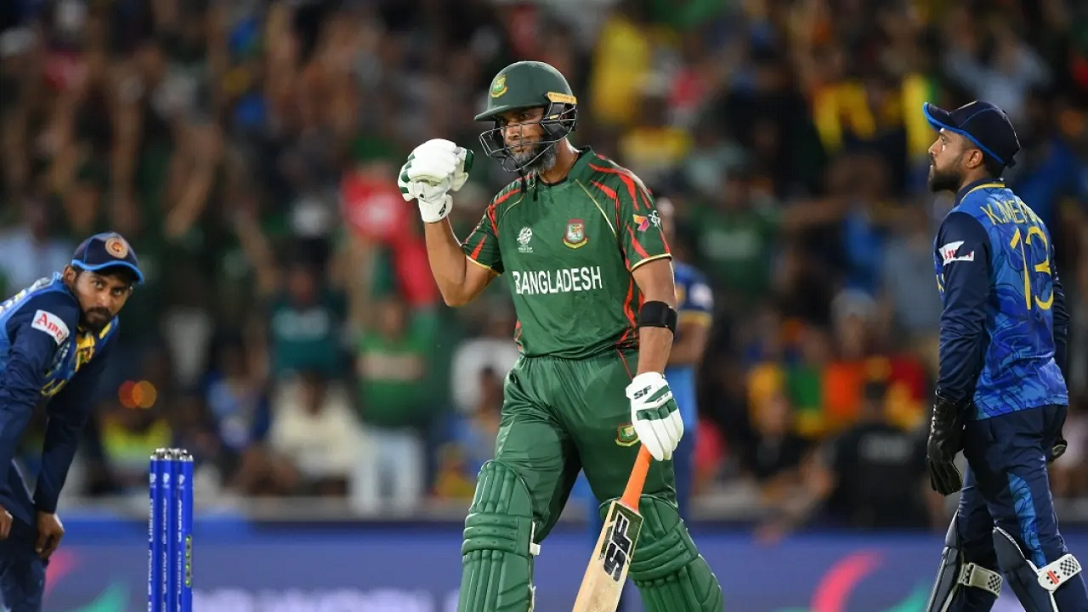
Nuwan Thushara’s last over brought Sri Lanka screaming back into the match,as he first bowled Rishad Hossain, and then nailed Taskin Ahmed in front of the stumps with a pinpoint swinging yorker. This left Bangladesh eight wickets down, with 12 runs still to get.
However, the experienced Mahmudullah was at the crease for Bangladesh, and despite some further nervy moments, pushed Bangladesh across the line off the last ball of the 19th over.
But this was a match chiefly decided by Bangladesh’s own outstanding bowling. Mustafizur Rahman was the best among them, using shorter lengths and his cutters efficiently, to claim figures of 3 for 17. Rishad Hossain’s three-for through the middle overs also kept Sri Lanka quiet.
Mustafizur was instrumental in Sri Lanka’s downward spiral through the middle overs, which culminated in a crash-and-burn end. Ultimately, their inability to find boundaries, or even rotate strike against good Bangladesh bowling resulted in their downfall. A score of 125 for 9 always seemed poor on a decent pitch, even if their bowlers made a match of it in the end.
Brief scores:
Bangladesh 125 for 8 in 19 overs (Towhid Hridoy 40, Litton Das 36; Dhanajaya de Silva 1-11, Nuwan Thushara 4-18, Wanidu Hasaranga 2-32, Matheesha Pathirana 1-27) beat Sri Lanka124 for 9 in 20 overs (Pathum Nissanka 47, Dhananjaya de Silva 21; Tanzim Hasan Sakib 1-24, Taskin Ahmed 2-25, Mustafizur Rahman 3-17, Rishad Hossain 3-22) by two wickets
[Cricinfo]
Latest News
Rashid, Farooqi and Gurbaz the stars as Afghanistan crush New Zealand
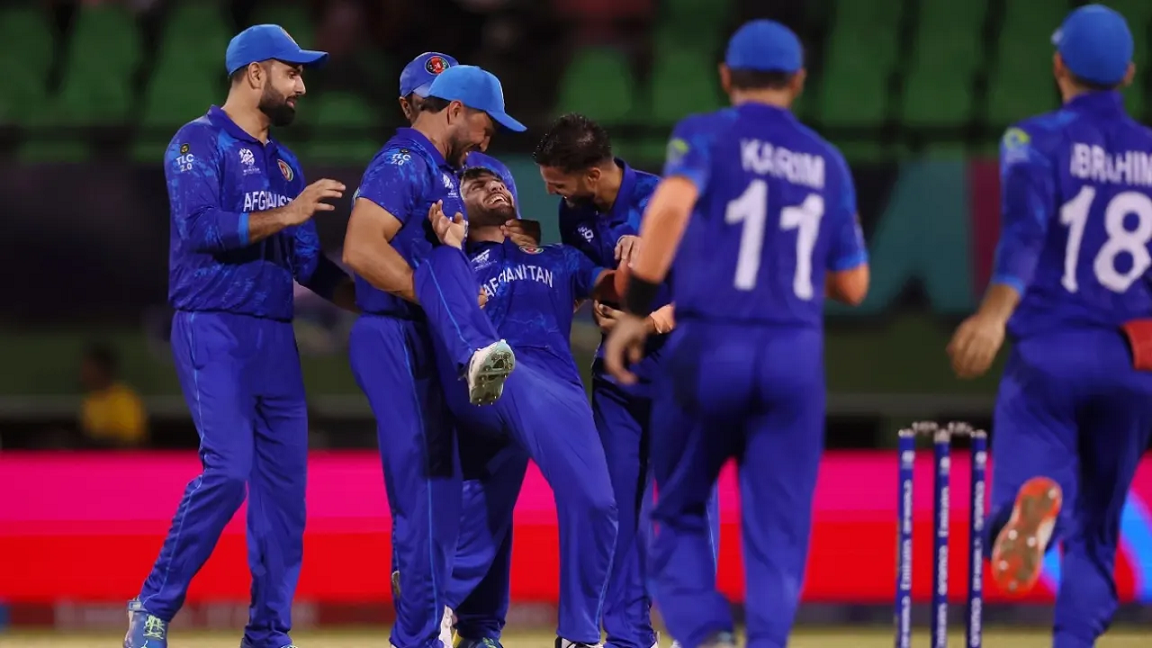
Afghanistan boosted their Super Eight chances with yet another dominating win, this time thumping New Zealand by 84 runs in Providence. Having beaten Uganda by 125 runs in their opening match, they are now at the top of Group C with a net run rate of 5.225.
After being sent in, Rahmanullah Gurbaz and Ibrahim Zadran gave Afghanistan a start of 103 in 14.3 overs. It came off the back of the 154 the pair added against Uganda, thus making them the first opening pair to register two successive century stands in the history of the T20 World Cup.
Afghanistan’s was an innings of two halves. They scored 55 for no loss in the first ten overs and 104 for 6 in the last ten, with Gurbaz contributing 80 off 56 balls. New Zealand, who had decided not to play any warm-up games, looked every bit rusty as their fielders dropped catches and missed run-out opportunities.
With the pitch assisting both seamers and spinners, chasing 160 was not going to be easy. But few would have expected New Zealand to collapse in the manner they did.
Fazalhaq Farooqi picked up three wickets in the powerplay and Rashid Khan three just after it. Eventually, both ended with identical figures of 4 for 17 as New Zealand were bowled out for 75 in the 15.2 overs. Glenn Phillips and Matt Henry were the only New Zealand batters to reach the double digits.
Trent Boult found some swing in the opening over but Gurbaz and Ibrahim showed their intent by picking up three fours off Henry from the other end. Both batters had luck on their side, too. Gurbaz got a second life when he skipped down the track to Santner and missed the ball, which went on to brush the leg stump but the bails did not budge. In the following over, Finn Allen dropped Ibrahim off Henry at the deep-square-leg boundary.
That was not all. Gurbaz got another reprieve after being involved in a miscommunication with Ibrahim. Having taken off for a single, Gurbaz had to retrace his steps and would have been run out had Conway not fumbled the throw.
Two balls later, New Zealand finally seemed to have found success when Santner pinged Ibrahim’s pads and umpire Kumar Dharmasena ruled it lbw. But the batter got the decision overturned on review as the ball was heading down the leg side. Immediately after that, Ibrahim hit Santner for an inside-out four as Afghanistan ended the powerplay on 44 for no loss.
New Zealand went against the prevailing wisdom of not bowling an offspinner when two right-hand batters at the crease, and Michael Bracewell repaid that faith by conceding only six off his first two overs.
Lockie Ferguson was even more frugal, going for five in his first two. He could have had Ibrahim off a slower full toss but a leaping Kane Williamson failed to pull off a one-handed stunner at mid-off. That meant while Afghanistan remained unscathed, they had only 55 on the board after ten overs.
Afghanistan had not hit a single six in the first ten overs, but there were five in the next three, including three in one Bracewell over as Gurbaz and Bracewell stepped on the accelerator. The pair took the side past 100 in the 14th over. New Zealand finally broke through when Ibrahim bottom-edged a short ball from Henry onto his stumps, after having been hit on the grille on the previous delivery.
Promoted to No. 3, Azmatullah Omarzai played his part with 22 off 13, which included two sixes in three balls off Henry. Mohammad Nabi fell for a first-ball duck but Gurbaz kept finding the boundary at regular intervals. However, a three-wicket, three-run final over by Boult kept Afghanistan to 159.
Farooqi gave Afghanistan a dream start with the ball. With the very first delivery of the innings, he uprooted Finn Allen’s leg stump as the ball moved in late. In the seamer’s next over, Conway pushed at one that seemed to come slower off the surface and was caught at extra cover.
The decision to give Farooqi a third over in the powerplay brought further rewards. This time, bowling around the wicket to Daryl Mitchell, he got a length delivery to just straighten and take the outside edge. Gurbaz took a regulation catch to complete the dismissal and leave New Zealand 28 for 3.
It could have been worse for New Zealand. In between, Naveen-ul-Haq had rapped Kane Williamson’s front pad after the batter had moved across to play a delivery. Afghanistan sent it upstairs for an lbw review but the umpire’s call saved the New Zealand captain.
Afghanistan did not have to wait too long for Williamson’s wicket. Rashid brought himself on after the powerplay and struck straightaway as Williamson guided one to first slip. But Rashid was just warming up. In his next over, he dismissed Mark Chapman and Bracewell off successive deliveries to leave New Zealand on 43 for 6. Chapman went for a pull and got bowled; Bracewell was late to bring his bat down and was lbw.
Phillips was New Zealand’s last hope. He did hit a couple of boundaries but was soon caught at long-on when he tried to take on Nabi. That ended any hopes of revival New Zealand might have had.
Brief scores:
Afghanistan 159 for 6 in 20 overs (Rahmanullah Gurbaz 80, Ibrahim Zadran 44, Azmatullah Omarzai 22; Trent Boult 2-22, Matt Henry 2-37, Lockie Fergusoan 1-28) beat New Zealand 75 in 15.2 overs (Glenn Phillips 18; Rashid Khan 4 for 17, Fazalhaq Farooqi 4 for 17, Mohammad Nabi 2-16) by 84 runs
[Cricinfo]


